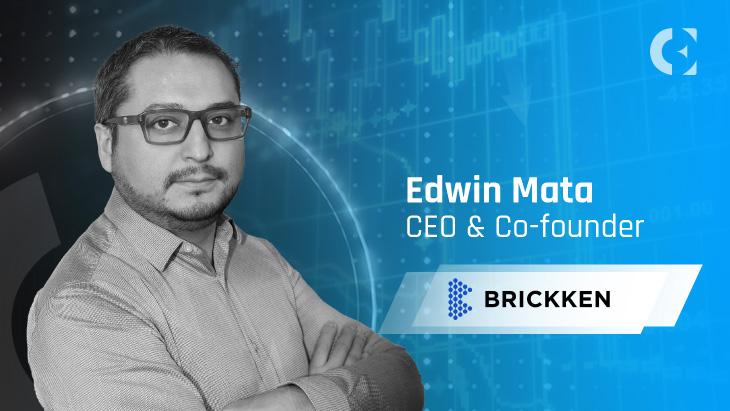Coin Edition sat down for an exclusive chat with Brickken CEO Edwin Mata, where he gave us the lowdown on how they’ve tokenized over $300M in real-world assets and the big impact that’s having on global liquidity.
Edwin also dives into how they’re navigating MiCA, using key partnerships, and tackling unique challenges in today’s evolving RWA market.
1. Brickken has utilized over $300M in assets globally. What is the key factor for this drive? Also, which asset classes are seeing the most demand?
Brickken’s $300M+ in tokenized assets stems from our full-stack infrastructure that abstracts blockchain complexity, ensures regulatory alignment, and offers rapid deployment for financial instruments such as equity, debt, and revenue-share models. The surge in demand is concentrated in private equity, real estate-backed instruments, and structured private credit, driven by issuers seeking programmable compliance and operational efficiency in fundraising and investor management.
2. How do you see RWA tokenization reshaping global trading and liquidity in the next 5 years.
Over the next five years, RWA tokenization will redefine cross-border capital markets by introducing 24/7 programmable liquidity, reducing settlement layers, and lowering issuance and compliance costs. The convergence of tokenized securities and DeFi will enable new secondary markets for illiquid assets, fostering global participation and unlocking trillions in idle capital, especially as legal frameworks and institutional infrastructure mature.
3. How does Brickken’s partnership with platforms like Polygon and BNB Chain enhance in scaling tokenized assets and boost adoption?
Our integration with BNB Chain and Polygon significantly enhances token scalability by enabling low-cost, high-throughput issuance across EVM-compatible networks. These partnerships also provide access to ecosystem support, liquidity channels, and investor networks, accelerating adoption for both SMEs and large institutions seeking compliant tokenization rails and multichain asset exposure. Additionally, this aligns with our Chainlink CCIP roadmap, enabling cross-chain interoperability and liquidity routing, so that asset issuers can capture capital efficiently across multiple blockchain ecosystems through a single issuance layer.
4. With the upcoming EU’s MiCA regulation, how is Brickken prepared, and what implications do you foresee for the wider tokenization space?
Brickken is fully prepared for the regulatory shift accompanying MiCA, despite MiCA not being applicable to securities or financial instruments, which fall under MiFID II. Our core infrastructure is designed to operate within both regimes. For tokenized securities, we maintain alignment with existing EU financial regulations and have tested our models in the European Blockchain Sandbox with 27 regulators. The broader implication is that MiCA will create clear rules for utility tokens and stablecoins, helping delineate regulated perimeters, reduce legal uncertainty, and accelerate adoption. For the tokenization space, this dual-track clarity will encourage institutional entry, especially for platforms that can distinguish between compliant securities tokenization and MiCA-regulated crypto-assets.
5. What unique challenges and opportunities have you encountered in RWA Tokenization?
The primary challenge has been regulatory fragmentation, especially when aligning legal frameworks across jurisdictions for asset issuance and investor onboarding. Additionally, the technological landscape remains fragmented, with numerous chains, token standards, and stablecoins lacking interoperability and in many countries still lacking legal certainty. However, each challenge has driven us to become more creative, pushing continuous innovation to align with evolving market conditions. Brickken’s modular architecture allows for local compliance adaptation while delivering standardized issuance infrastructure. With wallet abstraction and Chainlink’s CCIP on our roadmap, we are actively unifying fragmented ecosystems to offer a seamless, compliant tokenization experience across jurisdictions and technologies.
6. You’re participating in Token 2049 Dubai — what key themes or trends are you watching closely, and what does this event mean for Brickken’s global strategy?
Token2049 Dubai is a strategic forum for Brickken to engage with global allocators, regulators, and protocol builders. We’re closely watching themes such as institutional DeFi, modular infrastructure for RWAs, and regulatory convergence across the EU, UAE, and Asia. For Brickken, it is an opportunity to deepen partnerships, enter high-growth jurisdictions, and reinforce our position as a foundational layer for asset tokenization globally. It also enables us to meet prospective clients, understand emerging infrastructure and its rationale, and adopt the relevant know-how to embed within our platform ensuring we maintain the state-of-the-art standard our clients expect.
Disclaimer: The information presented in this article is for informational and educational purposes only. The article does not constitute financial advice or advice of any kind. Coin Edition is not responsible for any losses incurred as a result of the utilization of content, products, or services mentioned. Readers are advised to exercise caution before taking any action related to the company.







